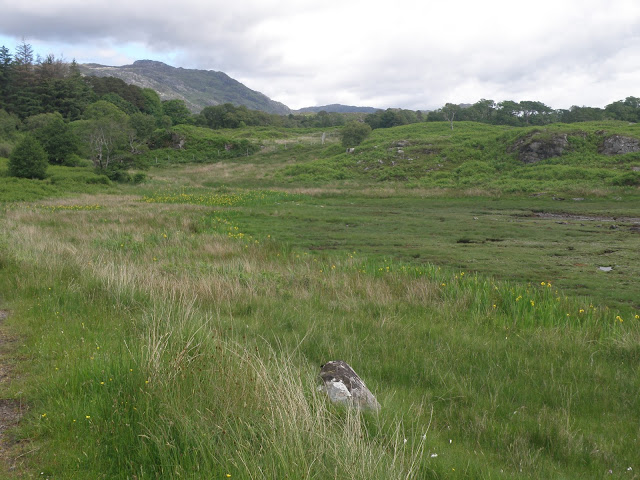For those who are unfamiliar with the
concept of square-bashing, I thought it might be instructive to show
how I approach the subject. The map below depicts the route I took on
9 June between Mallaig and Fort William. It involved a total of ten
stops, mainly on roadside verges as real 'sites' are often hard to
come by. Where I can, I try to stop by a stream or woodland so that
there is potential to collect Nematocera for the Cranefly and Fungus
Gnat schemes. In other places I stop for a matter of minutes when I
spot somewhere that might yield a few hovers: after all, every record
counts!
On this day, my aim was to cover part
of the west coast that is very poorly recorded. The day was not ideal
– a mixture of sunshine and showers – and there were very few
nectar sources. So, apart from checking out the occasional roadside
Rowan, it was a matter of sweeping to generate the majority of
records.
Even so, I did find two very nice
localities. The first was a lovely iris flush running to the
shoreline, which is very characteristic of the west coast of Scotland
Location 6 (photo 1); the second (Location 9, photo 2) was a
delightful section of stream with adjacent meadows covered in pignut
and with localised patches of brambles and dog rose. Both were
pleasant and the second site yielded a reasonable list of hoverflies.
Nevertheless, hoverflies were thin on the ground and I did far better
for Nematocera.
 |
| Photograph 1. Flushed shoreline with iris beds abutting saltmarsh in a continuous transition. |
 |
| Photo 2. Damp meadow with bramble and dog rose. |
When recording Nematocera I simply
hoover up everything that flies like a cranefly or gnat and then sort
them when I get home. I often end up with a pooter full of small
flies and refer to it as 'black grot' – which is frowned upon by
Peter Chandler as he loves fungus gnats. Photographs 3 and 4 show the
results – the pile of specimens for sorting, and the subsequent
piles of gnats and craneflies. I'm afraid neither shot is terribly
good as it was taken in the rather restricted light of my hotel room
and there was probably an element of camera shake given long exposure
time (I'm no photographer!). Out of this morass I also identify what
I can from other families, and pin a small amount of specimens for
identification in the winter (or a winter!). The end result often
yields records of Lauxaniidae, Empididae, Dolichiopodidae,
Tephritidae and Larger Brachycera, so lots of schemes benefit in the
long-run.
 |
| Photo 4. sample of Nematocera separated into craneflies and fungus gnats. |
This is the sort of recording that
others might wish to try. It is arguably the most effective way of
making sure that one uses one's time efficiently and makes sure that
as many schemes as possible benefit from what is a very expensive
trip. I will post more on the results when I get data back from Alan and Peter.


No comments:
Post a Comment